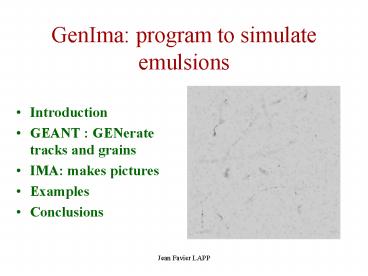GenIma: program to simulate emulsions - PowerPoint PPT Presentation
1 / 42
Title:
GenIma: program to simulate emulsions
Description:
The large feed-back time between beam tests and scanning is responsible for ... plane distance( 1/d2 et e-d/ ou =longueur d'absorption optique de l'emulsion) ... – PowerPoint PPT presentation
Number of Views:26
Avg rating:3.0/5.0
Title: GenIma: program to simulate emulsions
1
GenIma program to simulate emulsions
- Introduction
- GEANT GENerate tracks and grains
- IMA makes pictures
- Examples
- Conclusions
2
Introduction
- The lack of data for various conditions (
particle type, angles, energies, fog densities,
integration times, etc) and a poor statistics
make difficult the reconstruction programs
optimization. - The large feed-back time between beam tests and
scanning is responsible for these difficulties. - It was attracting to reproduce emulsions data by
Monte-Carlo, as for the other detectors, with the
hope to increase the comprehension of the
parameters influence, and to permit an
optimization of the designing of future beam
tests.
3
- PART 1 Particles generation in GEANT (3.2)
- ( IN PROGRESS)
- Problems with Geant to reproduce in the same
time ? electrons and the good relativistic rise
for dE/dX - ( We keep the coodinates of each energy
deposite Volume 20020044 ?3 (one layer ) ) - To get a density of 30 grains/100? en mean
for mip, I eliminate randomly points. ( same
result than to discriminate on energy deposite)
4
Pixels filling zone density f(r) in plan i
- focusing angle
- arcsin(N.A/n)
Grain x,y,z
?
Optical axis
r
5
- PART 2
- In a separate program
- For each grain x,y,z we calculate
intercepted surfaces by conical expansions
backward and upward , isolating zones of pixels
to fill. The cone aperture is determined by the
lense parameters
? arcsin(N.A/nrefr) - Pixels are filled with grey in each of the 16
picture planes grey densities vary with the
grain-plane distance( 1/d2 et e-d/? ou
?longueur dabsorption optique de lemulsion). - Size of grains is obtained by an appropiate
smearing - Field is 200200 ? for 1024 1024 pixels, 16
planes cone angle is 36 0 (pure Liban cedar
oil), or 64 0 (air) - Then add the wanted amount of random fog (6
grains/ (10 ?)3 ) and expand them also. - Pictures are written in Fortran (PPM format),
then converted in JPEG with XView.
6
Format PPM
- http//cedric.cnam.fr/gouet/Var/ppm.html
- Example toto.ppm
- P3
- 4 4
- 255
- red green blue
- 0 0 0 16 16 16 32 32 32 48 48 48
- 64 64 64 80 80 80 96 96 96 112 112 112
- 128 128 128 143 143 143 159 159 159 175 175 175
- 191 191 191 207 207 207 223 23 223 239 239 239
7
Oil and air (without fog)
- N.Ansin(?) n1. ou 1.52 ? 640 ou
360
8
Electrons tracks 0 to 1 Mev ? 20 0
horizontal, fog 6/1000 ?3
- Jean
Imad
9
Emulsion simulation
- 16 images
10
Emulsion simulation
- 16 images
11
(No Transcript)
12
Emulsion simulation
13
Emulsion simulation
- 16 images
14
Emulsion simulation
- 16 images
15
Emulsion simulation
- 16 images
16
Emulsion simulation
- 16 images
17
Emulsion simulation
- 16 images
18
Emulsion simulation
- 16 images
19
Emulsion simulation
- 16 images
20
Emulsion simulation
- 16 images
21
Emulsion simulation
- 16 images
22
Emulsion simulation
- 16 images
23
Emulsion simulation
- 16 images
24
Emulsion simulation
- 16 images
25
Find the vertex ! 5 muons emerging from a point
at 17 microns depth
26
(No Transcript)
27
(No Transcript)
28
(No Transcript)
29
(No Transcript)
30
(No Transcript)
31
(No Transcript)
32
(No Transcript)
33
(No Transcript)
34
(No Transcript)
35
(No Transcript)
36
(No Transcript)
37
(No Transcript)
38
(No Transcript)
39
(No Transcript)
40
(No Transcript)
41
(No Transcript)
42
Next steps
- Improve grain density f(dE/dX) , saturations, ?
rays - add the second layer
- Interface with microscope software
- Compare with available data ( ex efff(angle) )
- Version root, C ?
- Documentation
- Album of various backgrounds (compton fog,
refreshing actions) - Distorsion simulation
- Lyon inclined geometry?































